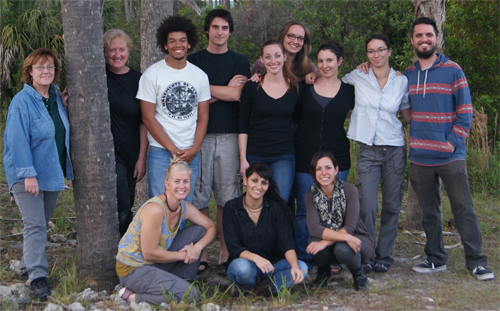March 12 ,2013
Kel and Meaghan
Today is Tuesday and somehow with everything going on we
missed the blog entry yesterday. Tricia has kept us all very busy with planned activities and so
Meg and I (Kel) are going to write about both days. Where to begin? Monday morning we awoke to our fabulous
breakfast of, bakes, fruit, eggs, and lemongrass tea. Following that we had a tibisiri workshop
with Latia. This involved taking the hearts of the Ite Palm and stripping them
of their fibers that create the materials used in basket weaving. We all got to
try our hand at weaving some baskets, although Mary and Michelle were the only
successful ones of the group. Kendry learned to braid while the rest of us made 'eco bling” bracelets. After a short rest and some lunch, we prepped for the
day’s workshop in school. The younger grades got to learn a bit about
printmaking using leaves and the rubber fish we brought. The older students worked with local clay and learned
how to make pinch pots and press bowls. This is the same clay used to make the
bricks used in the construction of their houses and buildings. Tricia also
introduced them to the Ocarina and had her class whistling away in no time. Some
of the students came back to the Caiman House where we showed the kids how to
make their own ocarinas. Leon John Park, one of the students in Tricia’s class,
was completely focused on learning how to make one, and by the end of the
session he had managed to figure out how to make an eight hole ocarina start
to finish entirely by himself – pretty amazing, considering that most of the
group still can’t do it without help. Later in the afternoon, a bunch of us met
up with some locals to play some football/volleyball while Kel and I (Meg) got
distracted by a nearby abandoned home that had lots of fun wood scraps which we
mosaicked into interesting geometric sculptures. Later that evening (after
another amazing dinner, of course) Tricia, Kendry and I finally got our turn to
participate in the nightly Caiman research night expedition. We all have some
really awesome experiences from the three different groups that went over the
weekend that we’ll post in another blog entry. We returned safely (all limbs
intact) took showers, hit the sack and had sweet dreams of gators, snakes, and
bakes.
So here we are on Tuesday, and yet again breakfast was
phenomenal, and we headed over to Auntie Madeline Francis’s home. She gave us a
tour of her field where she harvests all kinds of Cassava, the Amerindian
staple food. She showed us how to cut, harvest, and replant the cassava. We
proceeded to go back to her open air building where she peels, grates, strains
the toxins, and then cooks the Cassava into a bread. We had to cut our visit
short to get ready for today’s school work so tomorrow morning we’ll be back to
learn how to make and taste the bread. In school, we switched lessons so that
the younger grades could play with clay (they made pinch pots and little
animals) while the older grades did some printmaking. All of the kids had a
great time and the younger ones got to take clay home to play with it on their
own. After a brief break, Tricia, Kendry, Cydney, and I (Kel) went out fishing
with the two Felixes as our guides. The
catching was slow, the snags were plenty but overall Tricia and I each caught a
catfish. We finished the day off with a great dinner and preparation for the
next day’s final lesson at the school.



















